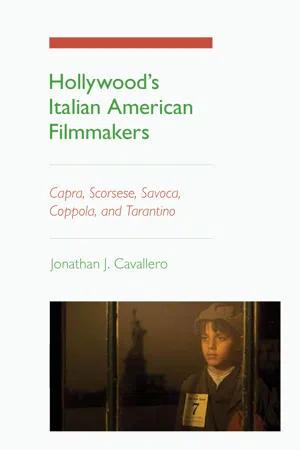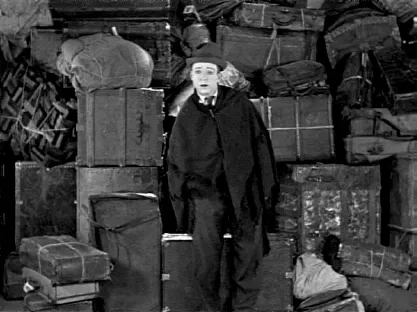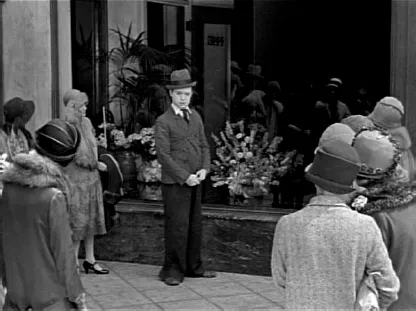![]()
1 Frank Capra
Ethnic Denial and Its Impossibility
In 1978, Dominic Candeloro wrote to Frank Capra asking him to be a speaker in the Italian American program at the University of Illinois at Chicago. Capra denied Candeloro’s request in a lengthy letter, writing:
Many times intellectual people ask me if my Italian heritage had anything to do with my work. And frankly, I don’t know what the hell they’re talking about. The word heritage evokes memories and spiritual experiences with the cultured heroes of the past. I never had such experiences. I am very proud to have been born an Italian, very proud of all the great men that Italy has produced in the arts and the sciences, very proud of the giant Italian intellects that created the Renaissance. But only as history, and as great men who contributed to making history. I admire Shakespeare and Tolstoi and Dante with equal reverence.
In that same letter, Capra described himself as a “10–90 Italian-American,” saying that he immigrated to the United States at such an early age that he had little memory of the land he left.1 Such remarks would seem to place Capra, who arrived in America at the age of six, firmly within the tradition of what Werner Sollors labels “consent” (4–6). By effectively denying his “descent” identity as an Italian, Capra consented to a new identity as an American.
Joseph McBride agrees with Capra’s self-assessment, arguing that the immigrant filmmaker, in an attempt to distance himself from his working-class, ethnic, immigrant origins, made films about “white” Americans (not ethnic others or immigrants) as a way of assimilating into American culture. Such a perspective reduces the impact of Capra’s ethnicity to something the director wished to deny, repress, or transcend. Lee Lourdeaux counters McBride’s (and Capra’s) claims by offering the first extended analysis of the ethnic elements of Capra’s films. By arguing that Capra was significantly affected by his ethnic immigrant origins, Lourdeaux lends credence to Michael Novak’s contention that our “emotions, instincts, memory, imagination, passions, and ways of perceiving are passed onto us in ways we do not choose, and in ways so thick with life that they lie far beyond the power of consciousness (let alone of analytic or verbal reason) thoroughly to master, totally to alter” (xvi).
More recently, Robert Sklar and John Paul Russo have investigated the ethnic themes in Capra. Sklar focuses his essay on For the Love of Mike (1927), a lost film, and The Younger Generation (1929).2 Russo includes a noteworthy analysis of For the Love of Mike while also providing the first serious consideration of Capra’s 1959 film, A Hole in the Head, the only Capra-directed work to take Italian Americans as its main characters. By arguing that these two ethnically focused films, separated by thirty-two years, share similar themes, Russo implicitly contends that an ethnic vein is present in select films throughout Capra’s career. Sklar, Russo, and Lourdeaux frame Capra as a “descent” artist and may open up similar avenues of research on other filmmakers who disavow their ethnic identity or have not been treated as ethnic artists.
Nonetheless, Sklar and Russo perpetuate the idea that ethnicity is a somewhat minor consideration when it comes to Capra. Lester D. Friedman implies a different view by suggesting that ethnicity is a vital consideration in the analysis of any director: “As a female director does not stop being a woman even when her film is not about overtly feminist issues, so one’s ethnic identity and sensibility do not disappear when he or she makes a film about non-ethnic issues. … Films, like other art forms, spring from the minds, hearts, and souls of men and women who speak in the language and partake in the activities of their world, even if their participation takes the form of denial, avoidance, and repudiation. Their culture shapes their daily experiences and artistic perceptions” (31, 33). This view is especially important when studying Capra, a filmmaker who worked during a period in American history when Italian ethnicity was heavily scrutinized. As Sklar has suggested, even if Capra attempted to “cancel” his ethnic identity, he still had a “very clear identity” for 1930s audiences (“Leap” 47). Sklar’s point is validated by the many interviews and personality profiles that noted Capra’s Italian identity, which were particularly prominent between the director’s rise to commercial and critical stardom in the mid-1930s and his return to Hollywood in the immediate post–World War II years.3 Usually, these references are made in passing, oftentimes simultaneously lauding the ability of this immigrant to succeed in America and U.S. exceptionalism for allowing immigrants such an opportunity. Other times, the director’s ethnic ties are given a more stereotypical treatment. In the February 24, 1940, issue of the New Yorker, for instance, Capra’s doctor attributed his childhood survival of a burst appendix to “the fact that Sicilians, conditioned by generations of knifings, have very hardy interiors” (Hellman 7). Thus, Capra was painted as an individual who was simultaneously able to benefit from an undesirable past while rising above it.
If Capra’s ethnicity was an issue for the public at large, it was also an issue for Italian Americans. In “The Master of the Human Touch,” published in Motion Picture in July 1935, Capra stated, “Every time the name of my birthplace appears in print, I get hundreds of letters from the hometowners who want me to read their scenarios or put their children into pictures. If I tried to answer half of them, I could make up my mind to shut up shop, and devote the rest of my life to correspondence” (Harrison 16). Capra’s comments suggest that some Italian Americans looked to Capra as a kind of culture hero similar to other prominent figures such as Joe DiMaggio, Fiorella La Guardia, and Frank Sinatra.4
Whether he felt influenced by his roots or not, Capra was viewed by many as a representative (if exceptional) Italian American, and it is surprising that scholarly work on Capra has largely marginalized the director’s ethnic identity. As we shall see, Capra introduced an ethnic aspect into a Hollywood cinema that often tried to erase ethnic difference.5 Rather than being of minor interest in a few Capra films, these ethnic immigrant concerns are a major aspect of his filmography, appearing in every phase of his nearly forty-year career. They are evident in his 1920s films, where Belgian, Irish, and Jewish immigrant characters struggle with conflicting American values like individualism and community or equality and capitalism. The Strong Man (1926), For the Love of Mike, and The Younger Generation argue for the necessity of immigrants’ inclusion and acceptance in American society while explicitly exploring various ethnic (though not Italian) immigrant experiences of the United States. In the 1930s, Capra’s 1920s explicitly immigrant protagonists are replaced by WASP Americans who migrate not to different countries but to different regions of America where they effectively undergo an immigrant experience, confronting the prejudice of entrenched interests and balancing the competing value structures of their previous lives with those of a new culture. On the surface, these films offer a traditional Hollywood narrative pattern, but when viewed in the context of Capra’s earlier films and his biography, they become stories of geographic relocation that double as allegories of immigration. Finally, in the early to mid-1940s, Capra’s involvement with wartime documentary production led to the “Why We Fight” films (1942–45), a series that attempts to counter Hollywood’s stereotyping of Italian Americans, even as it validates stereotypes of the Japanese and Germans. Ultimately, Capra’s life history and his work further our understanding of what it meant to be an Italian American immigrant in the first half of the twentieth century. By exposing the complex negotiation that he was forced to undertake as a Hollywood and governmental filmmaker, we gain a greater appreciation for the sometimes perilous and always complicated existence that ethnic Americans live.
Capra in the 1920s: The Explicit Immigration Tale
Capra’s filmmaking career began in the 1920s, a tumultuous decade for Italian Americans. Despite the prominence of baseball Hall of Famer Tony Lazzeri, banker Amadeo Pietro (A. P.) Giannini, and screen icon Rudolf Valentino, the decade was characterized by pervasive anti-Italian prejudice that at times became official governmental policy. The Immigration Acts of 1921 and 1924, prompted by widespread anti-immigrant sentiments, severely restricted the number of Italians (and other ethnics) that could immigrate to the United States. Meanwhile, within Italian American communities Mussolini’s rise to power led to deadly altercations between fascists and antifascists (Mangione and Morreale 318–20).
However, it was the seven-year ordeal of Nicola Sacco and Bartolomeo Vanzetti that crystallized popular opinions about Italian Americans. Avowed anarchists and atheists who were accused of a double murder, Sacco and Vanzetti were globally recognized by the time of their execution in 1927. Many were convinced of their innocence or at least their right to a retrial, while others were equally convinced of their guilt. Their case became a cause célèbre, with figures such as H. G. Wells, John Dos Passos, Upton Sinclair, Eugene V. Debs, and Emma Goldman coming to their defense. Helen Keller and Charlie Chaplin “took a vocal interest in the plight of the two political prisoners” (Davis 8), and protests attracted thousands throughout the United States and Europe.6 In a June 29, 1927, New Republic article, Bruce Bliven reported that the atmosphere in Boston was so contentious that the support of Harvard University faculty for Sacco and Vanzetti had adversely affected the annual fund drive and that schoolchildren were forbidden from discussing the case (67–68). Sacco and Vanzetti’s politics may not have helped their situation, but neither did their ethnic identities as immigrant Italians. As Jerre Mangione and Ben Morreale suggest, the Sacco and Vanzetti case indicates that the relationship between “those early immigrants and the rest of America” was a contentious one, characterized by prejudice, resentment, and sometimes violence (299).
Neither Capra nor any of his biographers have discussed how the Sacco and Vanzetti case affected him personally or professionally, but McBride’s meticulous research shows that Capra’s ethnicity was consistently an issue in his personal and professional relationships; in the 1920s, however, Capra’s public profile was not high enough for the Sacco and Vanzetti case to be a factor in his success. Nonetheless, the projects he undertook during the decade betray a consistent concern with the place of (non-Italian) immigrants in American society. So, while Capra’s ethnic identity as an Italian American is of vital importance (and would become more important later in his career), it might be more productive to approach his 1920s films from a perspective that stresses his more general identity as an immigrant.
Such a move expands the scope of the existing literature and reveals a degree of consistency not just between For the Love of Mike and The Younger Generation, as Sklar has suggested, but also between those films and Capra’s first feature, The Strong Man. These films take immigrants and immigrant families as their subject and feature main characters that have ethnic ties, immigrant identities, or both. This “otherness” complicates the characters’ lives, forcing them to negotiate between their ancestral roots and their professional and social aspirations. The American immigrant experience becomes the general subject of these films, but the specific conflicts of each narrative confront a different aspect of that experience. Throughout the decade, Capra’s criticism of the American establishment becomes more muted as his films instead focus on the right and wrong choices that individual ethnic immigrants and their children make. This minimizes institutional pressures and prejudices while assuming a degree of free choice on the part of the immigrant that might be best described as fantasy.
The Strong Man follows Paul Bergot (Harry Langdon), a childlike innocent who serves as a Belgian soldier during World War I.7 Even though combat surrounds him, Bergot becomes absorbed in a letter from his American pen pal, Mary Brown (Priscilla Bonner). While Bergot reads Brown’s letter, a burly German soldier named Zandow sneaks up on the Belgian and takes him prisoner.8 After the war, Zandow immigrates to America, bringing Bergot as his assistant. Zandow hopes his strongman act will bring him wealth and fame, but Bergot’s dream is to find Brown, with whom he has fallen in love. Impeding Bergot’s quest is a series of Americans who try to take advantage of him. After accidentally assaulting a laborer, Bergot flees Ellis Island (or what the film labels “the funnel of America”) with Zandow in tow. As he runs through the main hall, he unintentionally knocks down all of the pews on one side of the room, offering a not so subtle jab at Ellis Island’s dehumanizing immigrant processing routines. Eventually, our hero and Zandow arrive in Cloverdale, a border town that used to be a peaceful place and also, amazingly, the hometown of Mary Brown.9 Zandow’s love of alcohol and women renders him unable to perform his act, so the physically meager Bergot is forced onstage, where he performs his “feats” of strength for a raucous crowd. When the crowd insults Mary Brown, Bergot becomes her defender, eventually clearing the hall with a cannon that was supposed to hurl him through the air. Order and decency are restored; Bergot and Brown are coupled, and Bergot is granted the official position and the social standing of the town’s sheriff.
At the heart of The Strong Man is a conflict between “Old World” and “New World” values. The Old World, typified by Bergot and Brown, values family and romantic love over materialism (that is, American capitalism and the rise to success). Zandow counters this view by falling prey to New World values, which favor selfishness, greed, materialism, and vice. The film reaches its climax when these competing values come into direct conflict, and the audience is encouraged to side with the Old World characters. Nevertheless, being loyal to Old World values cultivates a form of naïveté. Here the casting of Harry Langdon becomes important. Langdon made a career of playing childlike innocents, and while Chaplin, Keaton, and Lloyd also constructed characters whose innocence endeared them to audiences and allowed them to triumph over foes, Langdon seems even less aware of the treachery that surrounds him.10 Capra’s work consistently returns to this kind of innocence, revealing a connection between immigrant characters like Bergot and later characters like Jefferson Smith.
In The Strong Man, Bergot’s innocence is closely connected to his immigrant standing, and both make him vulnerable initially. The film’s form works to emphasize this vulnerability and highlight the newly arrived immigrant’s precarious standing. Throughout the narrative, Capra shoots Bergot in mostly long and extreme long shots, which emphasize the enormity of Bergot’s new environment and his own smallness. Long shots of Bergot in Ellis Island place him among stacks of luggage and work to dehumanize him (fig. 2). When he ventures onto the streets of New York City to find Mary Brown, many of the Americans Bergot encounters “other” him. A woman yells at him, insisting that she is not Mary Brown, and Capra again uses long shots to emphasize Bergot’s bewilderment, showing masses of people filing by and gawking at the newly arrived immigrant (fig. 3). Soon after, a doorman (whom Bergot mistakes for a military commander) lies to Bergot, telling him that Mary walks by the nearby corner every day. This pattern continues when a prostitute-flapper, Lily of Broadway (Gertrude Astor), uses Bergot to avoid the police and then attempts to seduce him in order to retrieve the money she has, unbeknownst to him, hidden in his jacket.
Figure 2. Belgian immigrant Paul Bergot (Harry Langdon) is reduced to another piece of luggage in this shot from Frank Capra’s film The Strong Man.
Figure 3. Americans offer Bergot a cold welcome to the land of opportunity in The Strong Man. Capra uses the reflection in the store window to entirely surround Bergot.
Bergot’s innocence makes him an easy target. Nonetheless, like many of the Capra heroes who will follow, Bergot simultaneously benefits from his naïveté.11 As Peter Bogdanovich has argued, the character “comes up against hard reality yet manages not only to keep his illusions but to triumph with them” (quoted in Scherle and Levy 13). Ultimately, Bergot’s optimism fosters his continued belief in American myths. As a result, he is in one sense the most American of heroes. Most of The Strong Man’s other Americans are cynical and jaded and care only for themselves.12 United by a kind, virtuous nature that teaches them to care for other people, Brown and Bergot subsume their self-interest and help The S...


